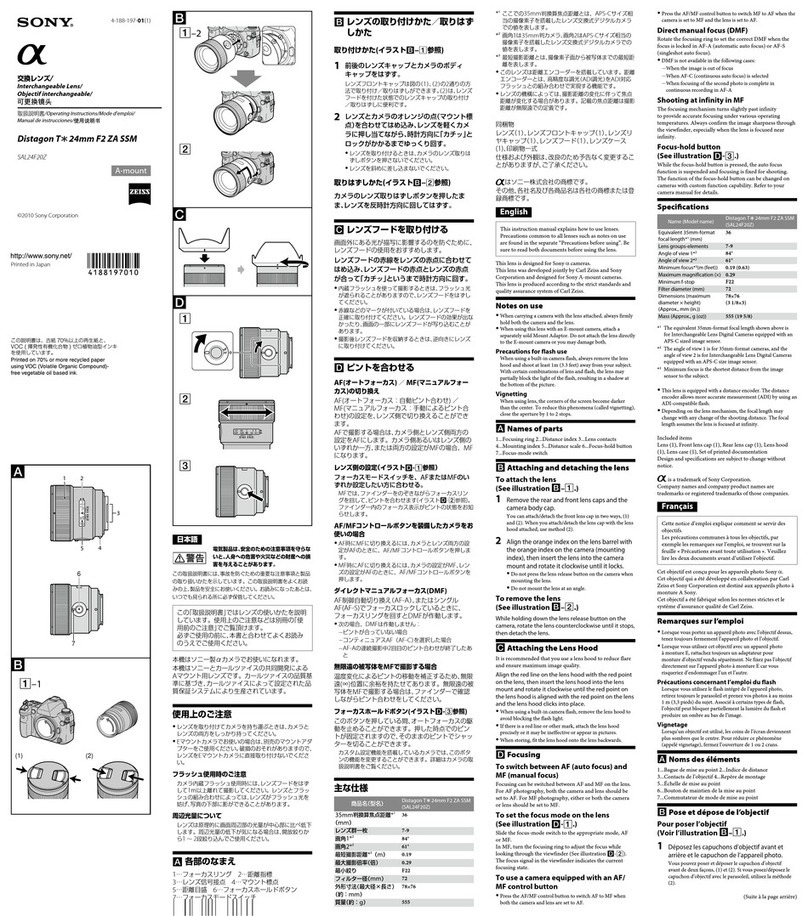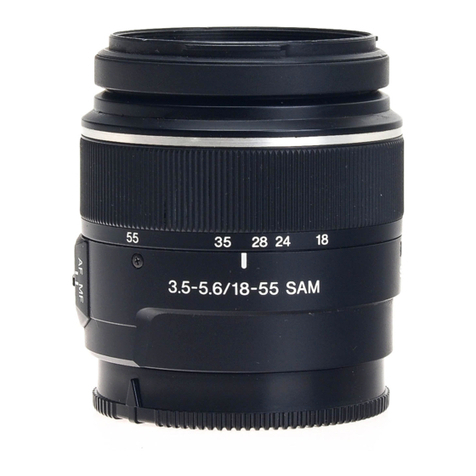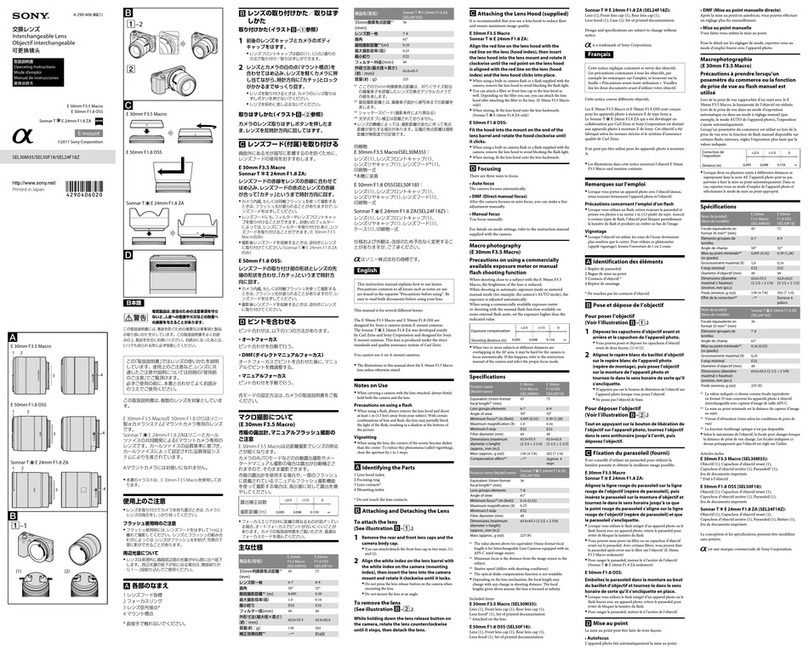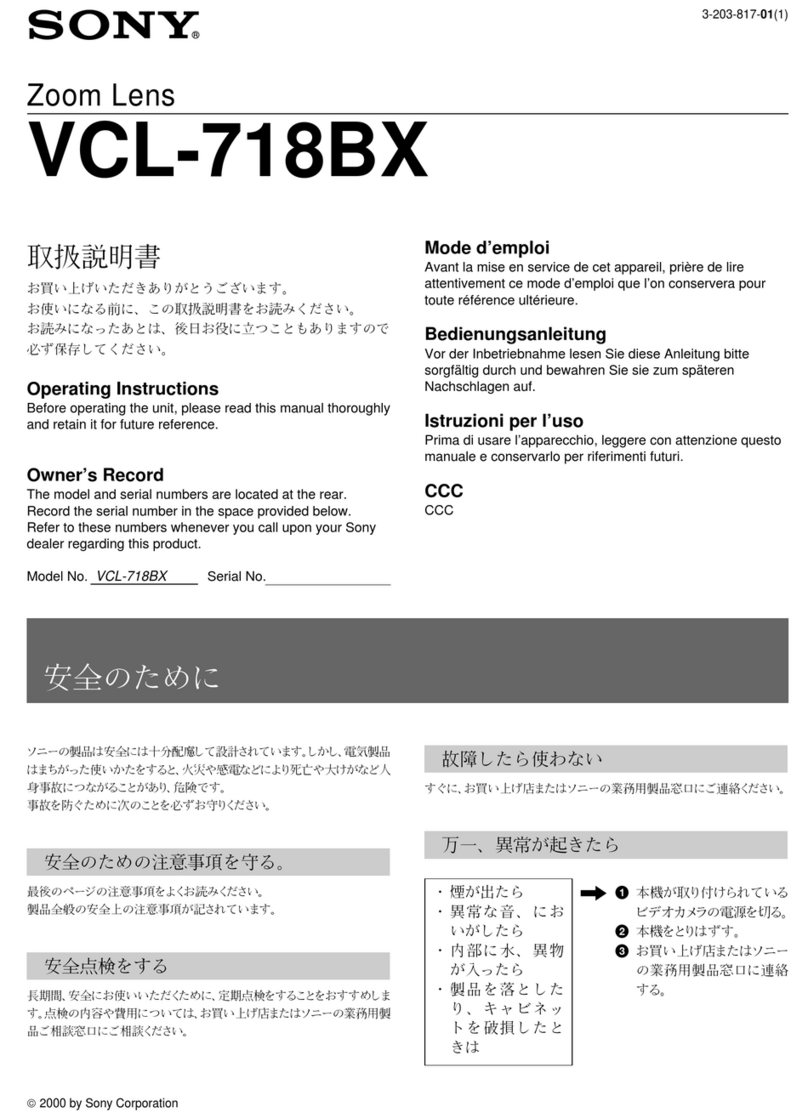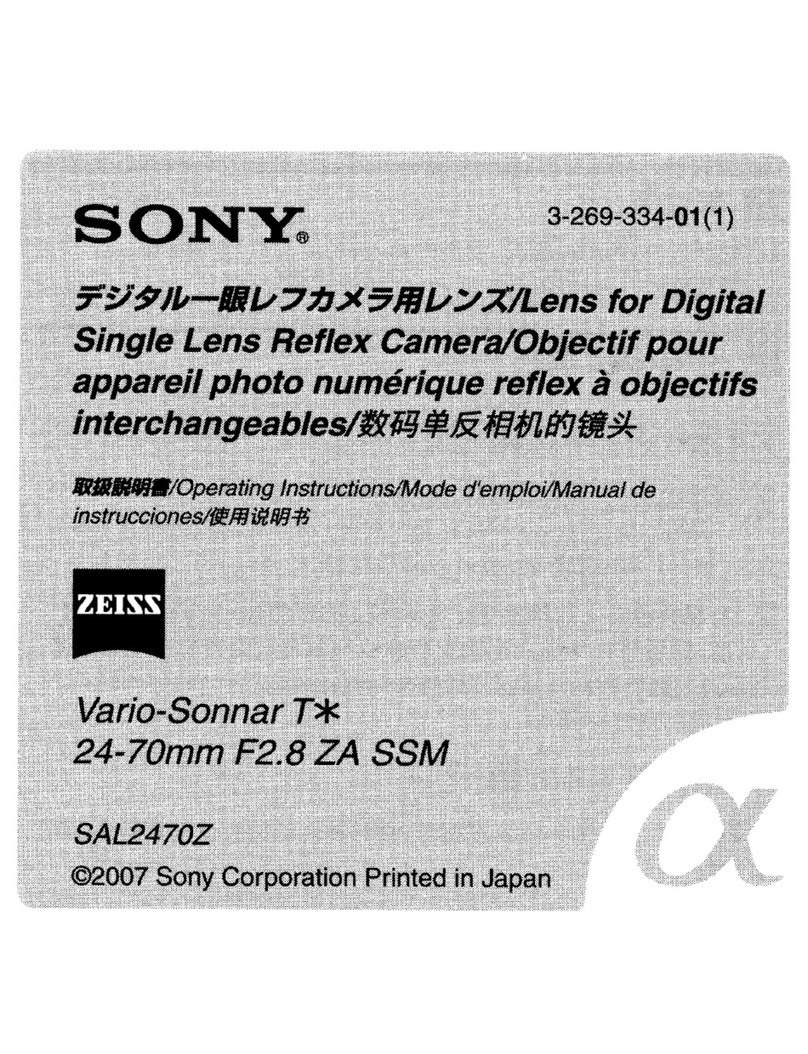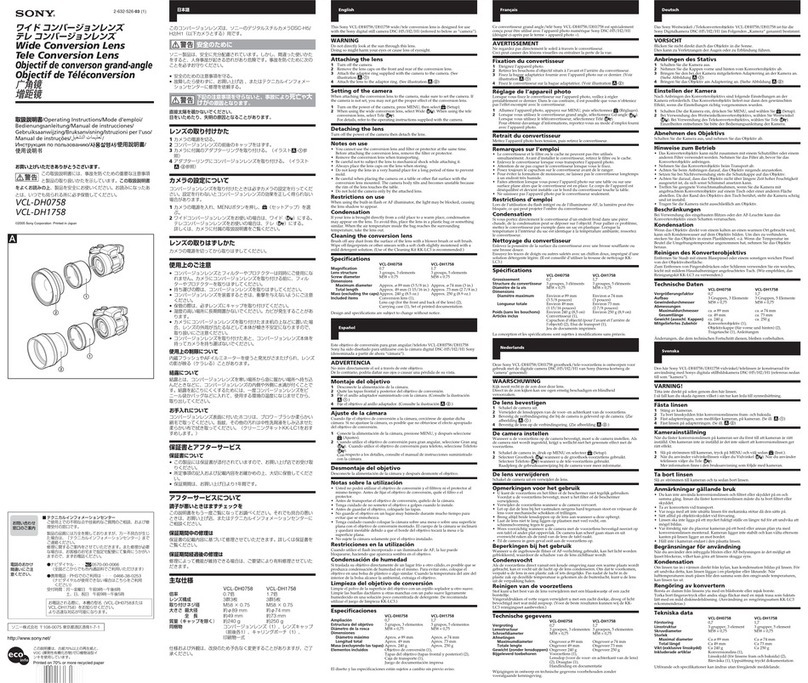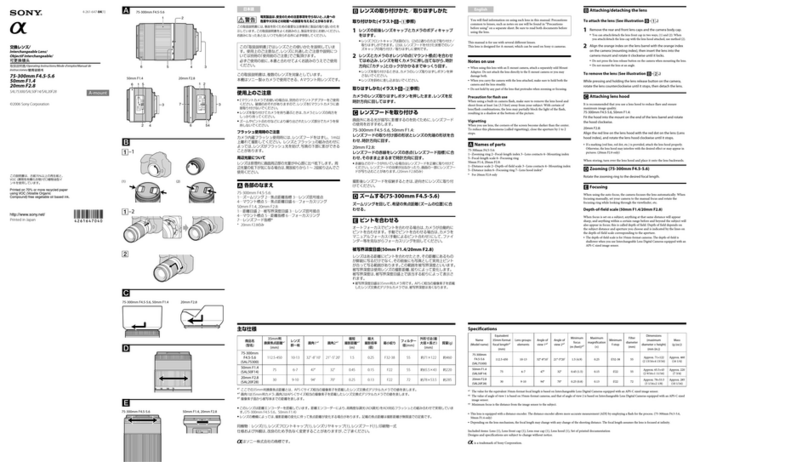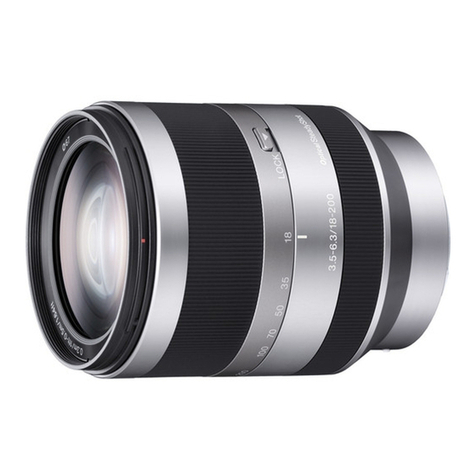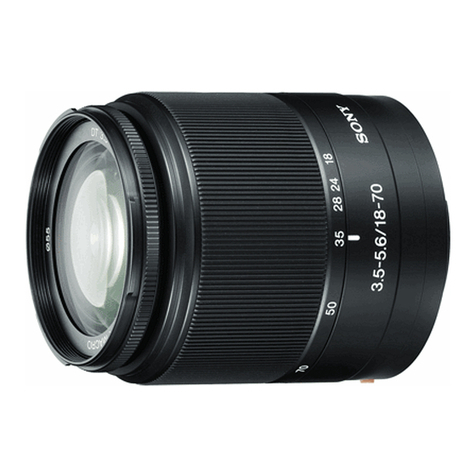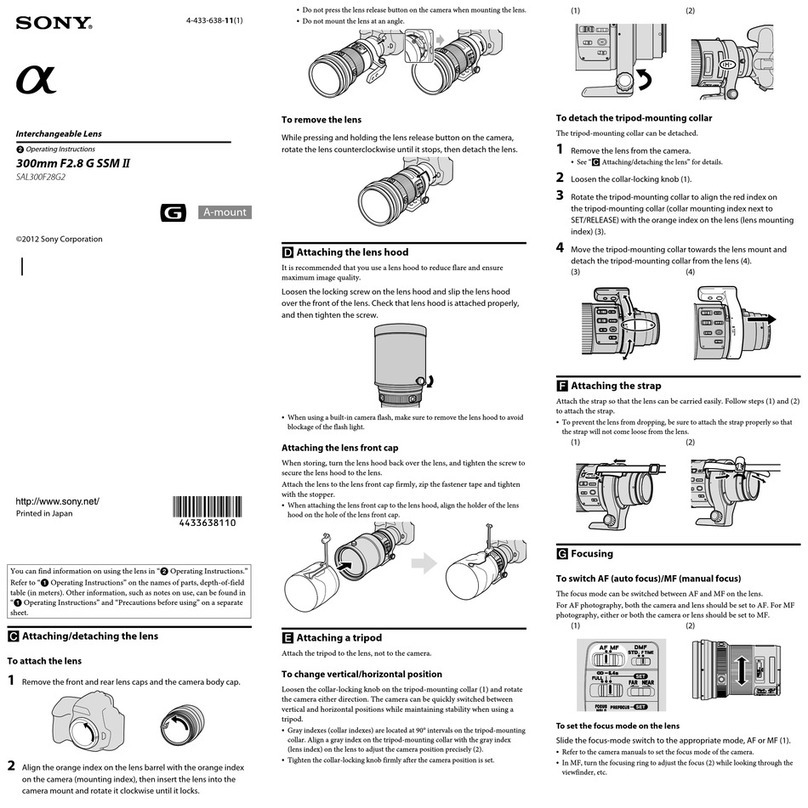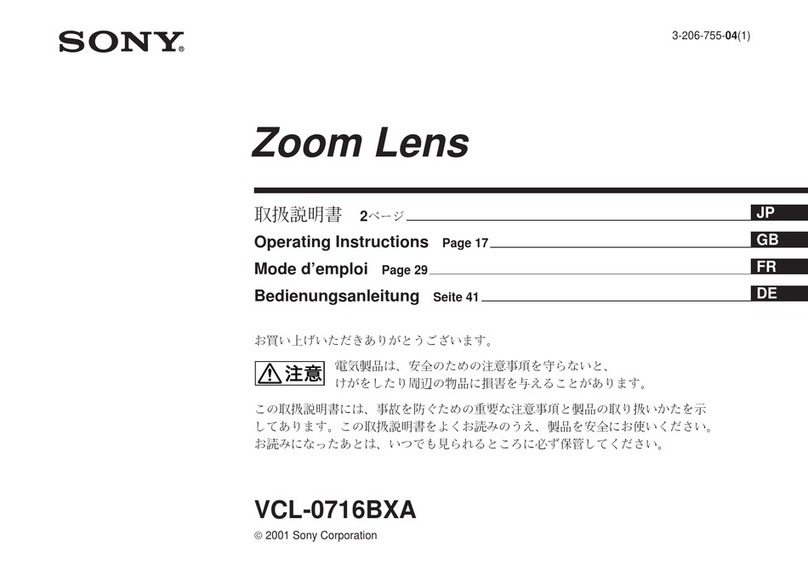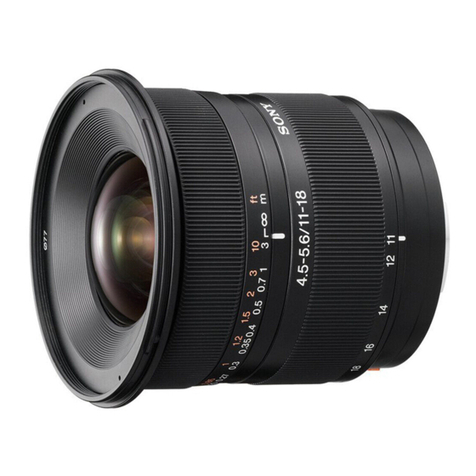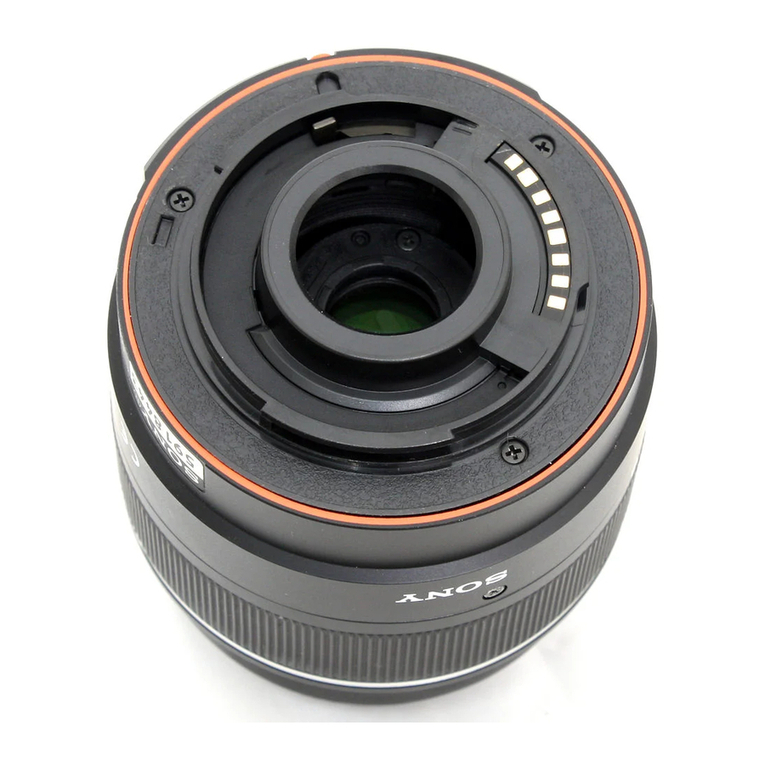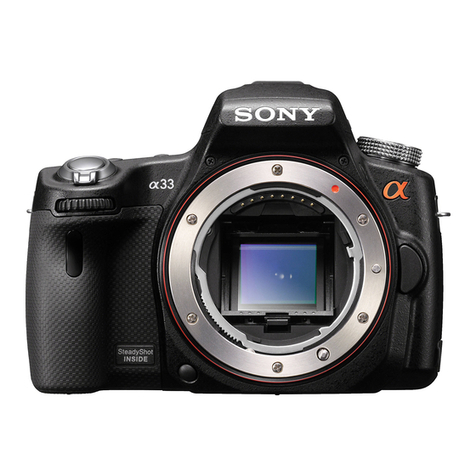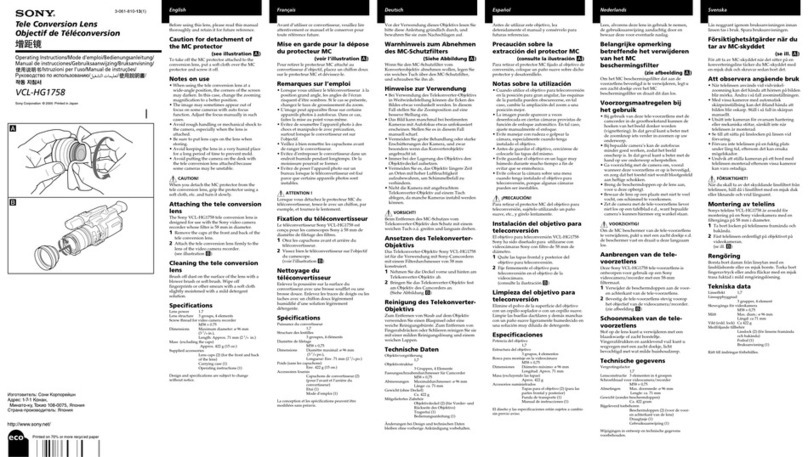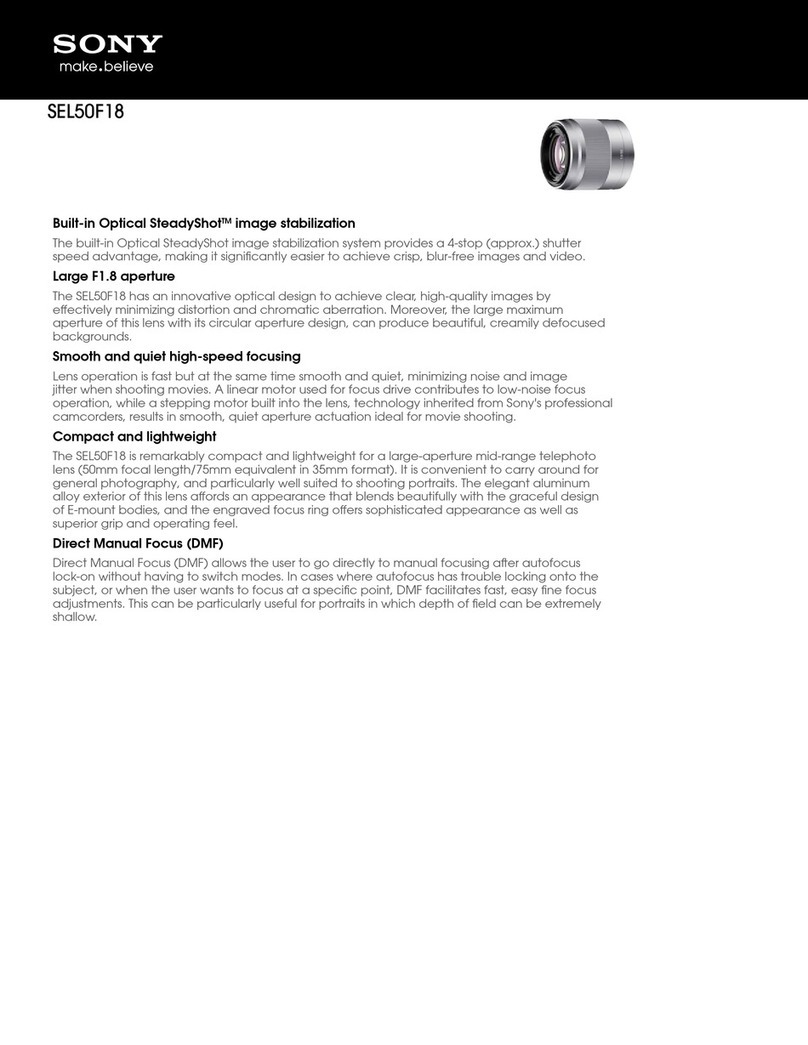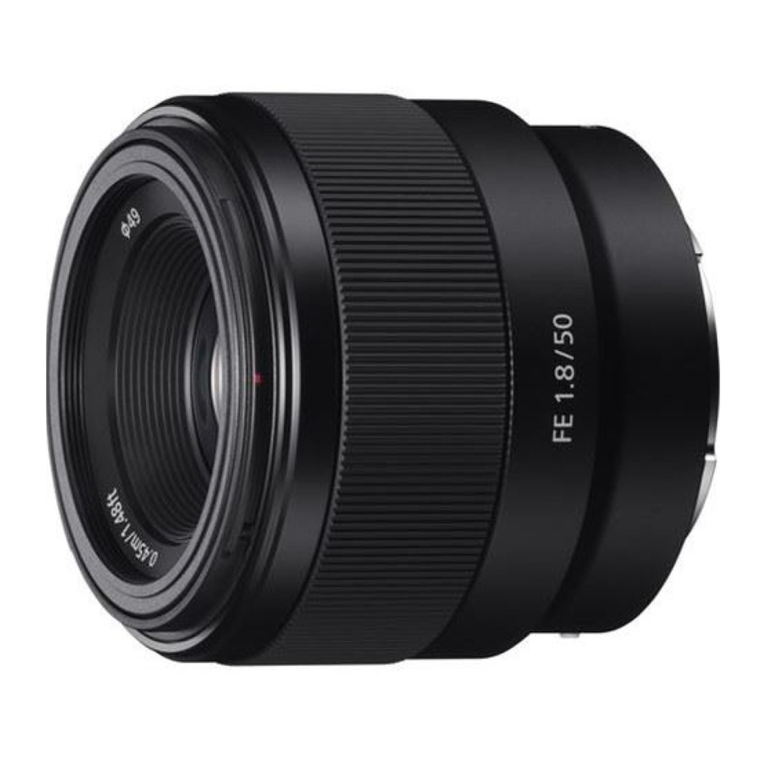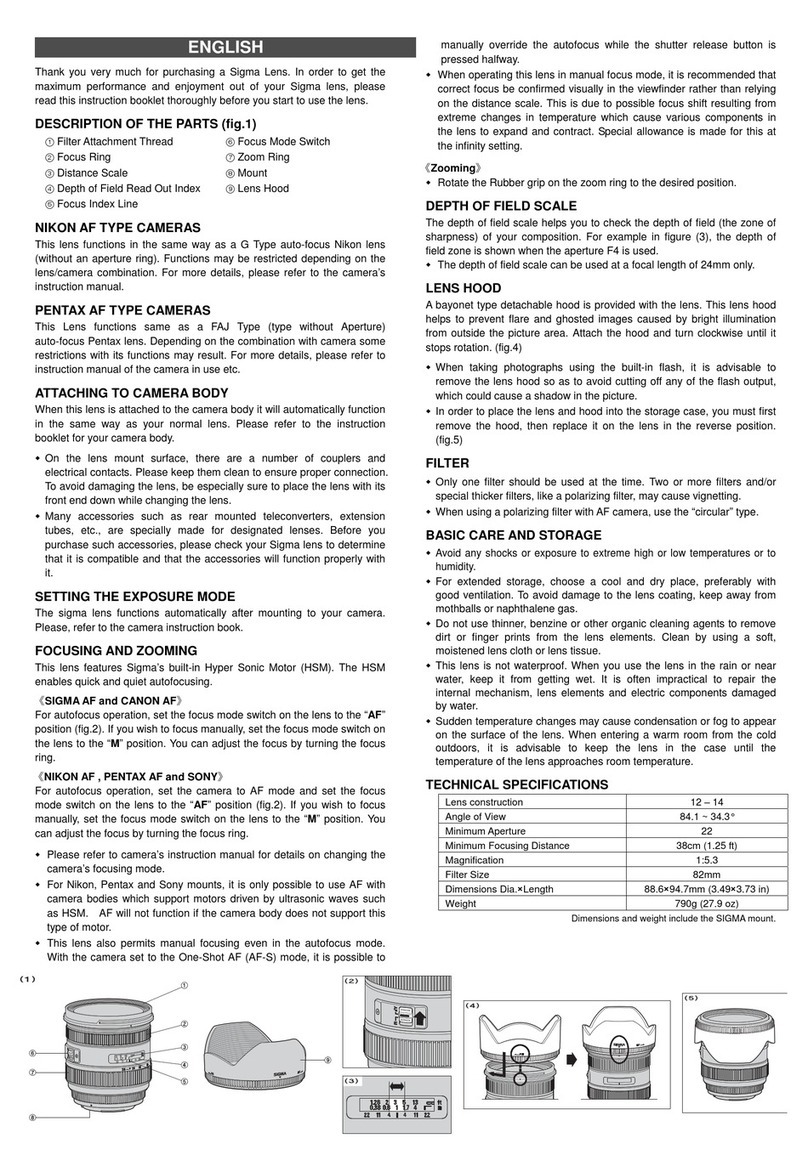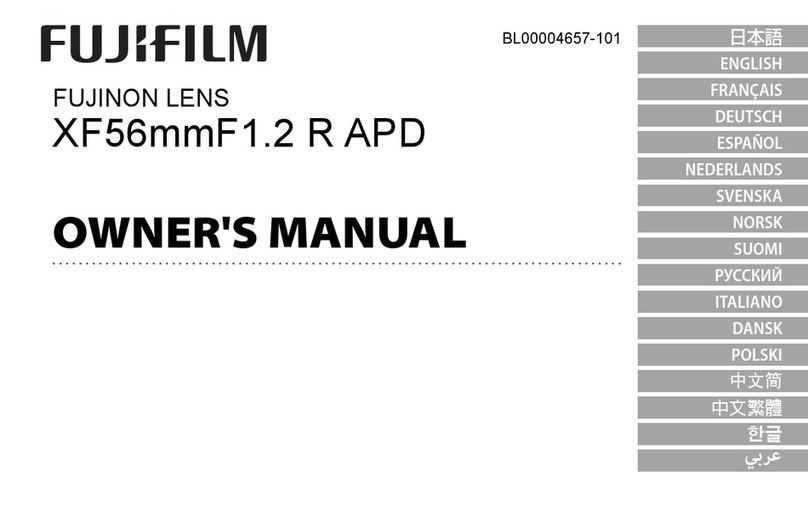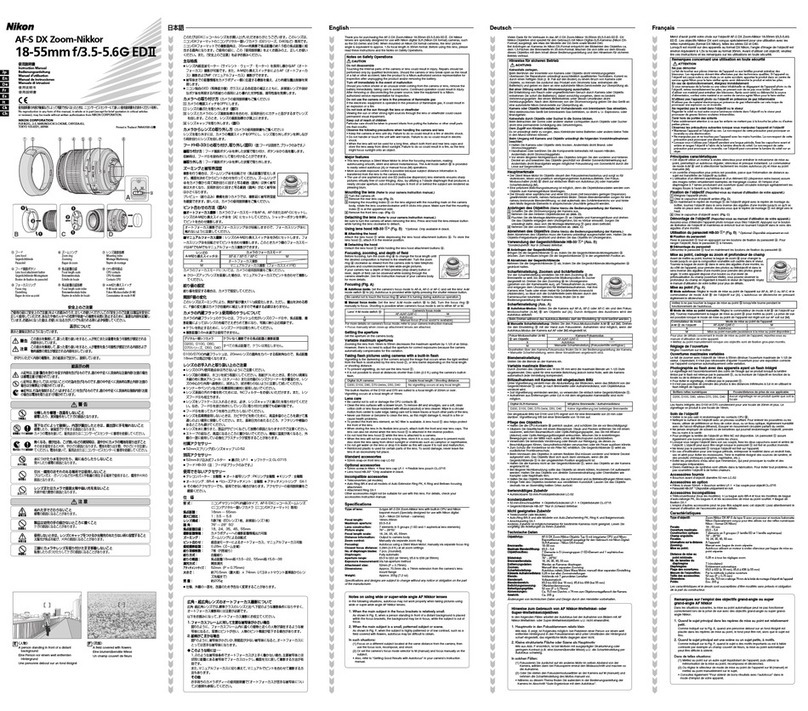–1
–2
取りはずしかた(イラスト–参照)
カメラのレンズ取りはずしボタンを押したま
ま、レンズを反時計方向に回してはずす。
レンズフードを取り付ける
画面外にある光が描写に影響するのを防ぐために、
レンズフードの使用をおすすめします。
レンズフードの取り付け部の形状とレンズの先
端の形状を合わせ、「カチッ」というまで時計方
向に回す。
内蔵フラッシュを使って撮影するときは、フラッシュ光
ˎ
が遮られることがありますので、レンズフードをはずし
てください。
撮影後レンズフードを収納するときは、逆向きにレンズ
ˎ
に取り付けてください。
ピントを合わせる
AF(オートフォーカス)では、カメラが自動的に
ピントを合わせます。
オートフォーカス作動中は、フォーカスリングが回転し
ˎ
ますので触れないでください。
カメラのダイレクトマニュアルフォーカスはお使いにな
ˎ
れません。(ダイレクトマニュアルフォーカス機能はカメ
ラによって搭載されていない機種もあります。機能を搭
載しているカメラは、カメラの取扱説明書のピントあわ
せのページにその記述があります。)
カメラのAF/MFボタンでのAF/MFコントロールはお使
ˎ
いになれません。(AF/MFボタンはカメラによって搭載
されていない機種もあります。機能を搭載しているカメ
ラは、カメラの取扱説明書のピントあわせのページにそ
の記述があります。)
MF(マニュアルフォーカス)では、ファインダー
をのぞきながらフォーカスリングを回して、ピ
ントを合わせます。(イラスト参照)
ファインダー内のフォーカス表示がピントの状態をお知
ˎ
らせします。
AF(オートフォーカス) /MF(マニュアルフォー
カス)の切り換え
オートフォーカス/マニュアルフォーカスの設定
は、レンズ側のフォーカスモードスイッチで切り換
えます。カメラ側のフォーカスモードスイッチ(レ
バー)はAFにして、ご使用ください。
マニュアルフォーカスは、必ずレンズ側のフォーカス
ˎ
モードスイッチをMFにしてご使用ください。切り換え
ずにフォーカスリングを無理に操作すると、故障の原因
になります。
無限遠の被写体をMFで撮影する場合
温度変化によるピントの移動を補正するため、無限
遠(∞)位置に余裕を持たせてあります。無限遠の被
写体をMFで撮影する場合は、ファインダーで確認
しながらピント合わせをしてください。
主な仕様
商品名(型名) 85mm F2.8 SAM (SAL85F28)
35mm判換算焦点距離*1
(mm)
127.5
レンズ群一枚 4-5
画角1*229°
画角2*219°
最短撮影距離*3(m)0.6
最大撮影倍率(倍) 0.2
最小絞り F22
フィルター径(mm)55
外形寸法(最大径×長さ)
(約:mm)
70×52
質量(約:g)175
*1ここでの35mm判換算焦点距離とは、APS-Cサイズ相
当の撮像素子を搭載したレンズ交換式デジタルカメラ
での値を表します。
*2画角1は35mm判カメラ、画角2はAPS-Cサイズ相当の
撮像素子を搭載したレンズ交換式デジタルカメラでの
値を表します。
*3最短撮影距離とは、撮像素子面から被写体までの最短距
離を表します。
このレンズは距離エンコーダーを搭載しています。距離
ˎ
エンコーダーとは、
高精度な調光(ADI調光)をADI対応
フラッシュとの組み合わせで実現する機能です。
レンズの機構によっては、撮影距離の変化に伴って焦点
ˎ
距離が変化する場合があります。記載の焦点距離は撮影
距離が無限遠での定義です。
同梱物
レンズ(1)、レンズフロントキャップ(1)、レンズリ
ヤキャップ(1)、レンズフード(1)、印刷物一式
仕様および外観は、改良のため予告なく変更するこ
とがありますが、ご了承ください。
はソニー株式会社の商標です。
This instruction manual explains how to use lenses.
Precautions common to all lenses such as notes on use
are found in the separate “Precautions before using”. Be
sure to read both documents before using the lens.
This lens is an A-mount lens designed for Sony α cameras.
Notes on Use
When carrying a camera with the lens attached, always firmlyˎ
hold both the camera and the lens.
Do not hold the camera by the part of the lens that protrudesˎ
when focusing.
When using this lens with an E-mount camera, attach aˎ
separately sold Mount Adaptor. Do not attach the lens directly
to the E-mount camera or you may damage both.
Precautions for flash use
When using a built-in camera flash, always remove the lens
hood and shoot at least 1m (3.3 feet) away from your subject.
With certain combinations of lens and flash, the lens may
partially block the light of the flash, resulting in a shadow at
the bottom of the picture.
Vignetting
When using lens, the corners of the screen become darker
than the center. To reduce this phenomena (called vignetting),
close the aperture by 1 to 2 stops.
Identifying the Parts
1...Focusing ring 2...Distance scale 3...Distance index
4...Lens contacts 5...Focus-mode switch 6...Mounting index
Attaching and Detaching the Lens
To attach the lens
(See illustration –.)
1Remove the rear and front lens caps and the
camera body cap.
You can attach/detach the front lens cap in two ways, (1)
and (2). When you attach/detach the lens cap with the lens
hood attached, use method (2).
2Align the orange index on the lens barrel with
the orange index on the camera (mounting
index), then insert the lens into the camera
mount and rotate it clockwise until it locks.
Do not press the lens release button on the camera whenˎ
mounting the lens.
Do not mount the lens at an angle.ˎ
To remove the lens
(See illustration –.)
While holding down the lens release button on the
camera, rotate the lens counterclockwise until it stops,
then detach the lens.
Attaching the Lens Hood
It is recommended that you use a lens hood to reduce flare
and ensure maximum image quality.
Fit the lens hood into the mount on the end of the
lens barrel and rotate the lens hood clockwise until it
clicks into place.
When using a built-in camera flash, remove the lens hood toˎ
avoid blocking the flash light.
When storing, fit the lens hood onto the lens backwards.ˎ
Focusing
When AF (Auto Focus) is selected, the camera focuses
automatically.
Do not touch the rotating focusing ring while the camera isˎ
focusing automatically.
You cannot use the camera’s direct manual focus functionˎ
with this lens. (Some cameras do not have a direct manual
focus function. If your camera has this function, this
restriction is explained in your camera’s instruction manual in
the section on focusing).
You cannot use the camera’s AF/MF button to controlˎ
AF/MF with this lens. (Some cameras do not have an AF/
MF button. If your camera has this button, this restriction
is explained in your camera’s instruction manual in the
section on focusing).
In MF (Manual Focus) mode, focus by rotating the
focusing ring while looking through the viewfinder.
(See illustration .)
The focus signal in the viewfinder indicates the currentˎ
state of focus.
To switch between AF (Auto Focus) and
MF (Manual Focus)
You can switch between Auto Focus and Manual Focus by
using the focus-mode switch on the lens. Be sure to set the
focusing mode switch (lever) on the camera to AF.
For manual focusing, be sure to set the focus-mode switch onˎ
the lens to MF. Rotating the focusing ring forcibly without
switching to MF may damage the focusing ring.
Shooting at infinity in MF
The focusing mechanism turns slightly past infinity
to provide accurate focusing under various operating
temperatures. Always confirm the image sharpness through
the viewfinder, especially when the lens is focused near
infinity.
Specications
Name (Model name) 85mm F2.8 SAM
(SAL85F28)
Equivalent 35mm-format
focal length*1(mm)
127.5
Lens groups-elements 4-5
Angle of view 1*229°
Angle of view 2*219°
Minimum focus*3(m (feet)) 0.6 (2.0)
Maximum magnification (×) 0.2
Minimum f-stop F22
Filter diameter (mm) 55
Dimensions (maximum
diameter × height)
(Approx., mm (in.))
70 × 52
(2 7/8 × 2 1/8)
Mass (Approx., g (oz)) 175 (6 1/8)
*1The equivalent 35mm-format focal length shown above is
for Interchangeable Lens Digital Cameras equipped with an
APS-C sized image sensor.
*2The angle of view 1 is for 35mm-format cameras, and the
angle of view 2 is for Interchangeable Lens Digital Cameras
equipped with an APS-C size image sensor.
*3Minimum focus is the shortest distance from the image
sensor to the subject.
This lens is equipped with a distance encoder. The distanceˎ
encoder allows more accurate measurement (ADI) by using an
ADI-compatible flash.
Depending on the lens mechanism, the focal length mayˎ
change with any change of the shooting distance. The focal
length assumes the lens is focused at infinity.
Included items
Lens (1), Front lens cap (1), Rear lens cap (1), Lens hood
(1), Set of printed documentation
Design and specifications are subject to change without
notice.
4-199-189-01(1)
©2010 Sony Corporation
Printed in Japan
交換レンズ
/
Interchangeable Lens/
Objectif interchangeable/
取扱説明書
/
Operating Instructions/Mode d’emploi/
Manual de instrucciones/
電気製品は、安全のための注意事項を守らな
いと、人身への危害や火災などの財産への損
害を与えることがあります。
この取扱説明書には、事故を防ぐための重要な注意事項と製品
の取り扱いかたを示しています。この取扱説明書をよくお読
みの上、製品を安全にお使いください。お読みになったあとは、
いつでも見られる所に必ず保管してください。
この「取扱説明書」ではレンズの使いかたを説明
しています。使用上のご注意などは別冊の「使
用前のご注意」でご覧頂けます。
必ずご使用の前に、本書と合わせてよくお読み
のうえでご使用ください。
本機はソニー製αカメラで使用できる、Aマウント
用レンズです。
使用上のご注意
レンズを取り付けてカメラを持ち運ぶときは、カメラと
ˎ
レンズの両方をしっかり持ってください。
ピント合わせにより繰り出されたレンズ部分でカメラを
ˎ
保持しないでください。
Eマウントカメラでお使いの場合は、別売のマウントアダ
ˎ
プターをご使用ください。破損のおそれがありますので、
レンズをEマウントカメラに直接取り付けないでくださ
い。
フラッシュ使用時のご注意
カメラ内蔵フラッシュ使用時には、レンズフードをはず
して1m以上離れて撮影してください。レンズとフラッ
シュの組み合わせによっては、レンズがフラッシュ光を
妨げ、写真の下部に影ができることがあります。
周辺光量について
レンズは原理的に画面周辺部の光量が中心部に比べ低下
します。周辺光量の低下が気になる場合は、開放絞りか
ら1〜2段絞り込んでご使用ください。
各部のなまえ
1…フォーカスリング 2…距離目盛
3…距離指標 4…レンズ信号接点
5…フォーカスモードスイッチ 6…マウント標点
レンズの取り付けかた/取りはず
しかた
取り付けかた(イラスト–参照)
1 前後のレンズキャップとカメラのボディ
キャップをはずす。
レンズフロントキャップは図の(1)、(2)の2通りの方
法で取り付け/取りはずしができます。(2)は、レンズ
フードを付けた状態でのレンズキャップの取り付け
/取りはずしに便利です。
2 レンズとカメラのオレンジの点(マウント標
点)を合わせてはめ込み、レンズを軽くカメ
ラに押し当てながら、時計方向に「カチッ」と
ロックがかかるまでゆっくり回す。
レンズを取り付けるときは、カメラのレンズ取りは
ˎ
ずしボタンを押さないでください。
レンズを斜めに差し込まないでください。
ˎ
is a trademark of Sony Corporation.
Cette notice d’emploi explique comment se servir des
objectifs.
Les précautions communes à tous les objectifs, par
exemple les remarques sur l’emploi, se trouvent sur la
feuille « Précautions avant toute utilisation ». Veuillez
lire les deux documents avant d’utiliser l’objectif.
Cet objectif est un objectif à monture A conçu pour les
appareils photo Sony α.
Remarques sur l’emploi
Lorsque vous portez un appareil photo avec l’objectif dessus,ˎ
tenez toujours fermement l’appareil photo et l’objectif.
Ne tenez pas l’appareil photo par la partie de l’objectif quiˎ
ressort lors de la mise au point.
Lorsque vous utilisez cet objectif avec un appareil photoˎ
à monture E, rattachez toujours un adaptateur pour
monture d’objectif vendu séparément. Ne fixez pas l’objectif
directement sur l’appareil photo à monture E car vous
risqueriez d’endommager l’un et l’autre.
Précautions concernant l’emploi du flash
Lorsque vous utilisez le flash intégré de l’appareil photo,
retirez toujours le parasoleil et prenez vos photos à au moins
1 m (3,3 pieds) du sujet. Associé à certains types de flash,
l’objectif peut bloquer partiellement la lumière du flash et
produire un ombre au bas de l’image.
Vignetage
Lorsqu’un objectif est utilisé, les coins de l’écran deviennent
plus sombres que le centre. Pour réduire ce phénomène
(appelé vignetage), fermez l’ouverture de 1 ou 2 crans.
Noms des éléments
1...Bague de mise au point 2...Échelle de mise au point
3...Indice de distance 4...Contacts de l’objectif
5...Commutateur de mode de mise au point
6...Repère de montage
Pose et dépose de l’objectif
Pour poser l’objectif
(Voir l’illustration –.)
1Déposez les capuchons d’objectif avant et
arrière et le capuchon de l’appareil photo.
Vous pouvez poser et déposer le capuchon d’objectif
avant de deux façons, (1) et (2). Si vous posez/déposez le
capuchon d’objectif avec le parasoleil, utilisez la méthode
(2).
2Alignez le repère orange du barillet d’objectif
sur le repère orange de l’appareil photo
(repère de montage), puis posez l’objectif sur
la monture de l’appareil photo et tournez-le
dans le sens horaire de sorte qu’il s’encliquette.
N’appuyez pas sur le bouton de libération de l’objectif surˎ
l’appareil photo lorsque vous posez l’objectif.
Ne posez pas l’objectif de biais.ˎ
Pour déposer l’objectif
(Voir l’illustration –.)
Tout en appuyant sur le bouton de libération de
l’objectif sur l’appareil photo, tournez l’objectif dans le
sens antihoraire jusqu’à l’arrêt, puis déposez l’objectif.
Fixation du parasoleil
Il est conseillé d’utiliser un parasoleil pour réduire la
lumière parasite et obtenir la meilleure image possible.
Emboîtez le parasoleil dans la monture au bout du
barillet d’objectif et tournez le parasoleil dans le sens
horaire de sorte qu’il s’encliquette.
Si vous utilisez le flash intégré de l’appareil photo, retirez leˎ
parasoleil pour éviter de bloquer la lumière du flash.
Pour ranger le parasoleil, insérez-le à l’arrière de l’objectif.ˎ
Mise au point
Lorsque AF (Mise au point automatique) est
sélectionné, l’appareil photo fait automatiquement la
mise au point.
Ne touchez pas la bague de mise au point lorsqu’elle tourneˎ
pendant la mise au point automatique.
Vous ne pouvez pas utiliser la mise au point manuelle directeˎ
de cet appareil photo avec cet objectif. (Certains appareils
photo ne présentent pas de mise au point manuelle directe. Si
votre appareil photo présente cette fonction, cette restriction
est expliquée dans le mode d’emploi de votre appareil photo
dans la partie concernant la mise au point.)
Vous ne pouvez pas utiliser la touche AF/MF de l’appareilˎ
photo pour contrôler la mise au point AF/MF avec cet objectif.
(Certains appareils photo n’ont pas de touche AF/MF. Si votre
appareil photo a cette touche, cette restriction est expliquée
dans le mode d’emploi de votre appareil photo dans la partie
concernant la mise au point.)
En mode MF (Mise au point manuelle), faites la mise
au point en tournant la bague de mise au point et
regardant dans le viseur. (Voir l’illustration .)
Le signal de mise au point dans le viseur indique l’état actuelˎ
de la mise au point.
Pour commuter entre AF (Mise au point
automatique) et MF (Mise au point
manuelle)
Vous pouvez commuter entre la mise au point automatique et
la mise au point manuelle à l’aide du commutateur de mode de
mise au point sur l’objectif. Veillez à mettre le commutateur de
mode de mise au point (levier) sur l’appareil photo sur AF.
Pour la mise au point manuelle, veillez à mettre leˎ
commutateur de mode de mise au point sur l’objectif sur MF.
La bague de mise au point peut être endommagée si vous
essayez de la tourner de force alors que le commutateur n’est
pas en position MF.
Prise de vue à l’infini en mode MF
Le mécanisme de mise au point dépasse légèrement
l’infini pour atteindre une plus grande netteté à diverses
températures de fonctionnement. Vérifiez toujours la
netteté de l’image dans le viseur, notamment lorsque le
réglage de l’objectif est proche de l’infini.
(Suite à la page arrière)
SAL85F28
85mm F2.8 SAM
